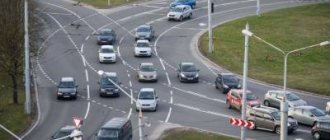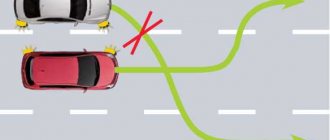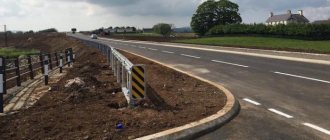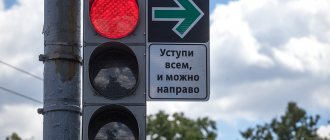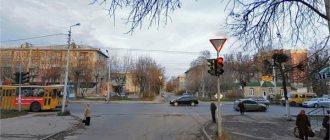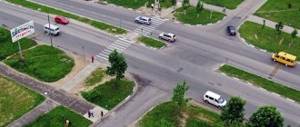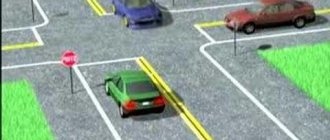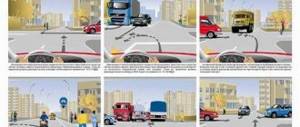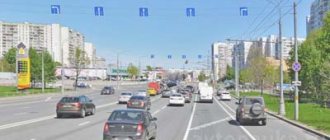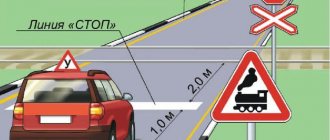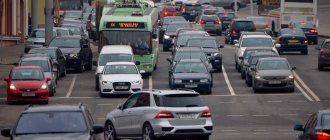Why define the boundary of an intersection?
The question arose from perhaps the only situation when it is necessary to determine the fact of entering an intersection, if a driver at a controlled intersection passes the stop line at the permissive traffic light signal, and by the time he approaches the imaginary border of the intersection, the prohibitory traffic light signal has already turned on. It would seem a stalemate. And I didn’t go to the intersection, and the red light was on, and I passed the stop line.
What should a driver of a red car do when passing a stop line and the traffic light turns on?
Let us immediately note that in the example there is no traffic jam and it is not prohibited to enter the intersection to turn. From April 28, 2021, this will already be expressly stated in the Traffic Rules. This is also not the only time such a situation has arisen.
Rules for driving at controlled intersections
The rules for driving through intersections with traffic lights are regulated by the traffic lights (which are the main ones) and the signals of additional sections.
Vehicles moving on the main green traffic light must determine priority among themselves in accordance with the “interference on the right” rule. Let's say you're turning left at a crossroads, and an oncoming car is moving straight ahead. When the green light turns on, you must enter the intersection, starting the maneuver, and let the oncoming car pass, and only then complete the turn.
If the red or yellow signals and the additional section of the traffic light are on at the same time, first let through all vehicles for which the main green signal is on, and only then move in the direction indicated by the signal of the additional section.
Video lesson: driving through intersections according to the rules.
Good afternoon, dear reader.
In the next article in the series “Rules for driving through intersections,” you will learn about the rules of the road that apply to uncontrolled equivalent intersections .
It is quite difficult to find such an intersection in a populated area. However, outside the city, equivalent intersections have become widespread, so every driver needs to clearly know how such intersections can be passed without violating traffic regulations.
I remind you that the driver must determine the type of intersection before the car enters that intersection. Previous articles in the series cover intersections:
At first glance, it seems that the rules for driving through intersections are unreasonably complex, since dozens of different situations are possible. In fact, everything is quite simple, and if you spend a few minutes studying the previous articles in the series, you will not have any problems.
As for uncontrolled equivalent intersections, only a couple of points of traffic rules apply to them, and therefore they should not cause any difficulties. These rules will be discussed below:
Term intersection
Traffic rules term "Crossroads"
| “Intersection” is a place where roads intersect, adjoin or branch at the same level, limited by imaginary lines connecting, respectively, the opposite, most distant from the center of the intersection, beginnings of curvatures of roadways. Exits from adjacent areas are not considered intersections. |
Let's go from the opposite. We will strictly adhere to every word and phrase.
place where roads cross, join or branch at the same level
Everything is clear, vehicles from at least two roads have crossing paths.
Exits from adjacent areas are not considered intersections.
It's also clear. They don't count, they don't count that way.
limited by imaginary lines connecting, respectively, the opposite, most distant from the center of the intersection, beginnings of curvatures of the roadways.
And this is where things start to get interesting. The driver must understand the intersection in front of him or not. First of all, the driver uses his imagination. Next, it looks for curves in roadways. At a simple intersection there will be eight of them, with a dividing strip already 12.
So, we have 12 points, they need to be connected, but not all of them. The driver does not understand whether this is an intersection or not until he strictly fulfills all the conditions of the definition.
We build imaginary lines. To do this, you need to select from the 12 beginnings of the rounding the ones that are most distant from the center of the intersection... Stop... The driver, strictly following the terms of the term, determines the intersection in front of him or not and must know the center of the same intersection that he is trying to determine. And all this in the process of movement.
After this, we can say that the boundaries of the intersection are arbitrary and do not have clear conditions for their definition.
What matters to a driver at an intersection? This is to know the place where the rules for passing intersections apply. The traffic rules do not require defining all the boundaries of an intersection.
General rules for driving through the intersection 2021
The general rules apply only to trackless vehicles:
- When at an intersection, motorists moving along the main route leave first. If paths intersect, drivers use the “car on the right” rule.
- Drivers on the secondary route are the last to leave the intersection. By analogy with the above rule, when crossing a trajectory, use the “auto on the right” rule.
To better understand the traffic rules, we recommend watching the video lesson “Driving through intersections according to the rules of 2018.”
We are trying to determine the boundaries of the term
Further, using examples strictly following the term “Intersection”, we will try to clearly determine the location of the intersection of roads.
The most common example of a deviation from the term “Intersection” is the borders of the junction of the road, forming a T-shaped intersection, where there are only 4 curves of the roadway.
T-junction
Branching roads where the curve can be of a huge radius.
Crossroads - a fork in the road
Please note that on the left behind the dividing strip, by definition, there is still the same intersection. Can anyone determine its boundaries by the curves?
The junction of roads at an acute angle, where there may be no curves at all.
Crossroads - junction of roads
Can snow affect the boundaries of the intersection?
Snowy Crossroads
We were unable to construct the boundaries of the intersection strictly according to the term in the examples above. If anyone succeeded, please write in the comments. This is another confirmation that the definition of the boundaries of the intersection is conditional and these boundaries are not needed for traffic.
Stop line - line of entry to the intersection
The same cannot be said about the means of organizing traffic at road intersections. In particular, these are traffic lights and stop lines. And it is after crossing the stop line that the vehicle finds itself in the zone regulating the intersection of traffic flows; after crossing the stop line, the vehicle finds itself at the intersection
and after crossing the stop line at the traffic light regulating traffic through the intersection, the driver must apply the rules for driving through the intersection.
This relates directly to the task posed at the very beginning of the material.
Using the examples above, we determined that imaginary lines from the beginning of the curves of the roadway do not define the boundaries of the intersection; in some cases, they are simply impossible to construct. No curve, no intersection?
Agree, when you approach a road intersection, the question rarely arises whether it is an intersection or not, and if so, where are its boundaries? In the Rules of the Road, the term “intersection” is used to regulate the rules of movement at the intersection of roads, and not as an instruction for defining clear boundaries of the intersection.
In the Convention on Road Traffic, the definition of an intersection is more general.
"Crossroads" in the Convention on Road Traffic
| the term "intersection" means any grade crossing, junction or branch of roads, including the area formed by such intersections, junctions or branches; |
And no rounding. Entry, exit and movement through the intersection are regulated by a special chapter of the Traffic Rules. The driver does not need to imagine any lines to determine the boundaries. Curves on the roadway are just a symbolic designation of the area where traffic flows from different roads intersect.
Rules for driving through unregulated intersections
Let's consider the basic rules of travel and possible situations for unregulated intersections of all types.
Equivalent intersection and driving rules
The rules for driving through intersections of equivalent roads are governed by the “interference on the right” rule - the driver must always give way to vehicles approaching from the right side of the roadway. This also applies to those cars that will become an “obstacle on the right” when the driver makes a maneuver.
Consider the situation: you are crossing an equivalent cross-shaped intersection straight ahead, without turning. There are two cars on the transverse road - one on the left (let's call it A), one on the right (it will be designated B), both plan to continue moving straight. According to the “interference on the right” rule, you give way to car B since it is on your right. In turn, vehicle A must give way to you in the same way.
The following situation: you are also crossing the intersection straight, and another car moving in the oncoming lane on the opposite side of the intersection intends to turn to your right (left for it). When starting her maneuver, she is obliged to slow down and let you pass, since your car will be an “interference on the right” for her when making a turn. The same rule works for reversals.
Rules for driving roundabouts
From November 8, 2021, new rules for driving around the roundabout come into force; according to the changes, drivers on the roundabout have priority when passing, and entering vehicles must give way.
At roundabouts, if all of its roads are of equal importance (there is no sign to give way) , then vehicles already on the roundabout must give way to those who are just about to enter, since they are still the same “obstacle on the right.”
When sign 2.4 “Give way” is installed in front of the roundabout , all vehicles entering the roundabout road are required to give way to all vehicles moving around the roundabout.
Also, in front of the roundabout, an information sign can be installed indicating the secondary and main roads when driving along the ring, but sign 4.3 “Roundabout” and sign 2.4 “Give way” must be installed, depending on the situation.
Driving through equivalent intersections with tram tracks
Rule 13.11 states that trams have full advantage over other trackless vehicles, regardless of the direction of movement. Here, the car owner does not receive any benefits from the "interference on the right" scheme. In this case, trams are equal in front of each other and when crossing an intersection at the same time they must be guided by the same rules as ordinary cars.
Fines
You will never be charged with driving through a prohibiting traffic light when crossing a stop line at a permitting signal.
You can easily and justifiably be charged with violating the requirement to stop in front of the stop line at a prohibitory traffic light. Please note that the fine is not for passing the stop line at a prohibitory signal, but for stopping.
Part 2 of Article 12.12 of the Code of Administrative Offenses of the Russian Federation
| 2. Failure to comply with the requirement of the Traffic Rules to stop in front of a stop line indicated by road signs or road markings, when there is a prohibiting traffic light signal or a prohibiting gesture from a traffic controller, entails the imposition of an administrative fine in the amount of eight hundred rubles. |
The rules require that when a stop signal is given, the vehicle must stop in front of the stop line. This means that it is prohibited to stop behind the stop line at the prohibitory signal of this traffic light and this is the basis for a fine.
Do you think that if it is not directly prohibited, then it is allowed? Then this link is for you.
Stopping behind the stop line is a violation of the requirements of paragraph 13.7 of the Rules
Peyrn 13.7 Traffic rules
| 13.7. A driver who enters an intersection when the traffic light signal permits must drive in the intended direction regardless of the traffic light signal at the exit from the intersection. |
We crossed the stop line and entered an intersection. There is no need to imagine any other lines.
